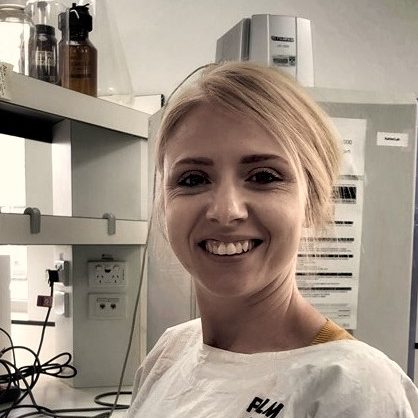Shantelle Claassen-Weitz
Postdoctoral Research Fellow; University of Cape Town
Dr. Shantelle Claassen-Weitz is a postdoctoral research fellow within the Division of Medical Microbiology at the University of Cape Town. She has a great appreciation for molecular tools to investigate how imbalances in microbial communities can result in disease. She is also very interested in microbe-microbe and microbe-host interactions, and the development of therapeutics for infections.
Dr. Claassen-Weitz’ research has primarily been focused microbial communities of the upper respiratory tract and their role in lower respiratory tract infections (LRTI) in regions with high levels of poverty. She explains that: “LRTI is preventable, yet we do not know how to prevent it. It remains the biggest killer of children under the age of five with its primary victims being children from sub-Saharan African countries. It therefore made perfect sense to investigate the aetiology of these infections within the largest epidemiological birth cohort study in Africa, the Drakenstein Child Health Study.”
Ms. Claassen-Weitz explains that having the opportunity to set up a laboratory for performing 16S rRNA amplicon sequencing locally in South Africa has been one of her many great achievements. She has authored eleven publications and has received awards from several organisations including Harry Crossley Research Fellowship, National Research Foundation, Oppenheimer Memorial Trust and L’Oreal UNESCO Women in Science.
As postdoctoral research fellow she continues to perform research in the field of microbiology focusing on LRTI during infancy. In addition, her postdoctoral research now also involves working on various projects investigating the role of gastrointestinal microbes in health and disease states. She is also involved in a multidisciplinary, multi-centered, prospective laboratory-based cohort study which aims at integrating clinical and molecular epidemiology of Carbapenem-resistant Enterobacteriaceae among in-patients in both private and public sectors in the Cape Town Metropole, South Africa. She hopes to contribute to preventative strategies and therapeutics for a range of diseases.
Qualifications: BSc in Microbiology and Physiology; BSc (Med) Honours in Infectious Diseases and Immunology; MSc (Med) in Medical Microbiology; PhD (Med) in Medical Microbiology.
Abstract
Background: Nasopharyngeal (NP) bacterial community profiles are increasingly recognised as key role-players mediating susceptibility to aetiology and severity of lower respiratory tract infection (LRTI). We investigated associations between nasopharyngeal bacterial communities and LRTI in children in a low-middle-income setting with a high burden of LRTI.
Methods: We conducted a case-control study of infants enrolled in the Drakenstein Child Health Study (DCHS), a birth cohort in Cape Town, South Africa. NP specimens were collected at LRTI (323 episodes of LRTI in 242 children) and age matched non-LRTI controls in the cohort (323 specimens from 259 controls). Nucleic acid was extracted and the V4 hypervariable region of the 16S rRNA gene sequenced. Pooled libraries were sequenced on the Illumina® MiSeqTM platform. DADA2 pipeline was used to infer amplicon sequence variants (ASVs). Taxonomy was assigned using the RDP classifier implementation for DADA2 and SILVA v138.
Results: NP specimens from LTRI cases had higher bacterial load (p=0.0022) and higher numbers of bacterial species (Chao1 index) (p=0.0131) compared to non-LRTI controls. Aitchison- and Bray-Curtis-based Permutational Multivariate Analysis of Variance (PERMANOVA) showed that bacterial communities differed between cases and controls. Using MaAsLin2, we found that Haemophilus [ASV2 q<0.0001 and ASV3 q=0.125] and Streptococcus [ASV10 (presumed S. mitis) q=0.048] had higher relative abundance among LRTI cases compared to controls. Conversely, Dolosigranulum [ASV6 (presumed D. pigrum) q=0.001], Corynebacterium [ASV4 (presumed C. pseudodiphtheriticum) q<0.069], and Moraxella [ASV1 (presumed M. catarrhalis/nonliquefaciens) q=0.101] had higher relative abundance among controls.
Conclusions: These results indicate differences in bacterial profiles in LRTI cases compared to controls, which may underlie pathogenesis. Further studies to define the role of NP bacterial communities should be performed at species-level using a longitudinal approach to better understand the pathogenesis of infant LRTI.
Funding: This work was supported by the Bill and Melinda Gates Foundation, USA (grant number OPP1017641); the National Research Foundation, South Africa, the National Institutes of Health H3Africa (grant number U01AI110466-01A1), and the South African Medical Research Council.

